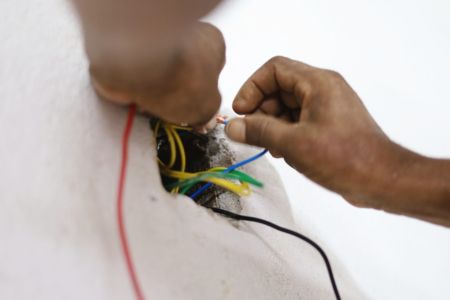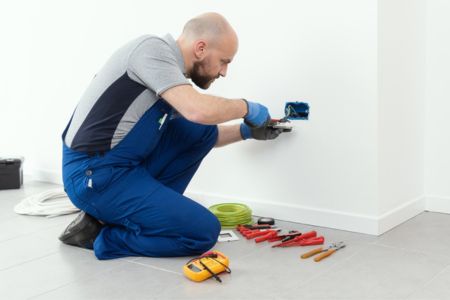A Ground Fault Circuit Interrupter (GFCI) outlet is an essential safety feature in modern homes. It works by continually monitoring the flow of electricity between the hot and neutral wires. If it detects any imbalance or ground fault, it automatically stops the power to prevent potential electrical shock hazards.
It's common for a GFCI outlet to trip occasionally due to temporary factors such as a small appliance causing a ground fault or wet conditions in the area. However, if your GFCI outlet keeps tripping frequently without an apparent reason, it could be a sign of a more serious issue requiring attention.
Let's explore some common reasons why your GFCI outlet might keep tripping.
Table of Contents
Your GFCI outlet might keep tripping for several reasons, ranging from simple to more complicated issues. The most common cause is a ground fault, when the electrical current is disrupted. This can be due to moisture, damaged insulation, or faulty appliances.
Another reason is worn-out outlets. Over time, an outlet's internal mechanisms can fail, causing frequent tripping even without a ground fault. Overloaded circuits are another common issue. Plugging too many devices into one circuit can exceed the load capacity, triggering the GFCI as a safety measure.
In some cases, faulty wiring or components in the GFCI outlet may be to blame. To ensure safety, it’s important to have an electrician inspect and replace damaged outlets or wiring.
Frequent GFCI tripping should be addressed promptly, as it may signal electrical hazards like shocks or fires. To prevent this, keep appliances in good condition, avoid using damaged cords, and never use electrical items near water. Also, avoid overloading outlets by plugging in too many devices.
Regularly test your GFCI outlets by pressing the “test” button. The reset button should pop out—if it doesn’t, the outlet may need replacing.
When a GFCI outlet constantly trips when you plug something in, it may indicate a faulty or high-powered appliance. The GFCI outlet serves as a safety measure by detecting imbalances in the electrical current. If it senses an imbalance, electricity flows somewhere it shouldn't, such as through a person to the ground, it will immediately trip to prevent potential electrocution.
To identify the source of the problem, start by unplugging all devices from the GFCI outlet and then reconnecting them one at a time. This will help isolate which device is causing the trip. It's also essential to check for any visible damage on the plugs or cords of your appliances.
To verify that the GFCI outlet is functioning correctly, test it with an appliance you know works. If the outlet continues to trip, the issue may lie with the GFCI outlet itself not working. In that case, it’s best to have it inspected and replaced by a licensed electrician.
If you find that one particular appliance is causing the GFCI outlet to trip, a professional must inspect and repair it. Do not use the appliance until it has been restored.
If all devices are unplugged but the GFCI outlet continues to trip, there may be an issue with the wiring or the outlet itself. Calling a licensed electrician to assess and fix the problem is crucial in this case.
If your GFCI outlet keeps tripping after a reset, it may signal an issue that needs attention. Understanding the cause is essential to prevent hazards and keep your home safe.
One common reason is faulty wiring. Loose connections or broken wires can cause frequent tripping. Call a professional electrician to inspect and repair the wiring in this case.
Another cause could be an overloaded circuit. Too many appliances plugged into one outlet or circuit can exceed the load limit and trigger the GFCI. To avoid this, spread out your electrical usage across different circuits.
Water entering the outlet, especially in damp areas like bathrooms or kitchens, can also cause tripping. Make sure the area around the outlet is dry before resetting the GFCI.
Another possible reason is a ground fault in a connected appliance. This points to a wiring issue within the device, which can be hazardous and should be handled by an electrician.
Lastly, GFCI outlets have a limited lifespan. If the outlet keeps tripping after following safety steps, it may be time for a replacement.
GFCI outlets often trip after exposure to rain or moisture, which can be a problem for outdoor outlets or damp areas like bathrooms and kitchens. To prevent this, ensure outlet covers are weatherproof and tightly sealed to keep moisture out. Caulk any gaps around the outlets and use moisture-resistant electrical boxes for installations in damp locations.
Regular maintenance is essential for outdoor GFCI outlets. Test them periodically and replace any that show wear or damage. Install outdoor outlets at least 12 inches above ground and away from water sources like sprinklers or hoses.
When using extension cords with outdoor outlets, ensure they are rated for outdoor use and undamaged. Use only one cord per outlet, never daisy-chain them. Following these steps will help keep your outlets safe and functional.

If any of these signs are present, you must take action and replace your GFCI outlet as soon as possible. This will help ensure your safety and the electrical system of your home.
Call a licensed electrician if you have noticed any signs of a malfunctioning GFCI outlet. Electricians are trained professionals who can assess the situation and perform the required repairs or replacements to ensure the safety of your home.
In some cases, water damage may have affected your GFCI outlet, making it unsafe to handle alone. Water and electricity do not mix well and can create dangerous situations if mishandled. It is always best to leave any water-related electrical issues to a professional.
Complex wiring can also be a factor in determining when to call an electrician. If you are unsure about the wiring in your home or are experiencing issues with your electrical system, it is best to call an electrician. Fixing complex wiring issues without proper knowledge and training can be hazardous and lead to further damage.
Additionally, regular maintenance checks on your home's electrical system are necessary. This can prevent potential hazards from occurring and keep the system running smoothly. During a maintenance check, an electrician can inspect your electrical system's wiring, outlets, and other components and make necessary repairs or replacements.
GFCIs can be sensitive and may trip frequently, causing inconvenience and potential hazards. Here are some maintenance tips to prevent GFCI outlet trips in the future:
By following these tips, you can ensure the safety of your home and loved ones by properly maintaining GFCI outlets. Always consult a licensed electrician if you have any concerns or need assistance with installation or repair.

We understand the importance of reliable and safe electrical systems for your home or business. That’s why we offer fast, efficient GFCI repairs, home wiring, and upgrades in Tampa Bay and nearby areas. Our team is dedicated to keeping your electrical system up to date and ensuring compliance with all safety standards.
Malfunctioning GFCI outlets should be addressed quickly to ensure everyone's safety on your property. Our electricians will assess the issue and provide the most suitable solution for your needs.
Don’t wait to fix GFCI issues. Contact us today for reliable repairs and upgrades in the Tampa Bay area. Our licensed electricians help keep your property safe and up to code.